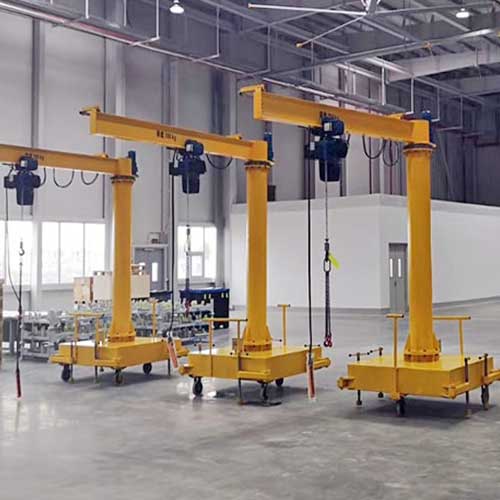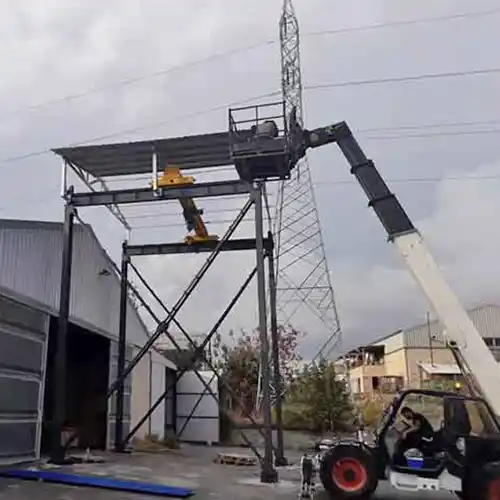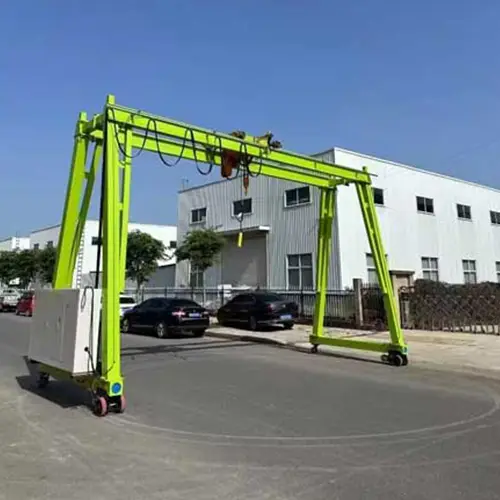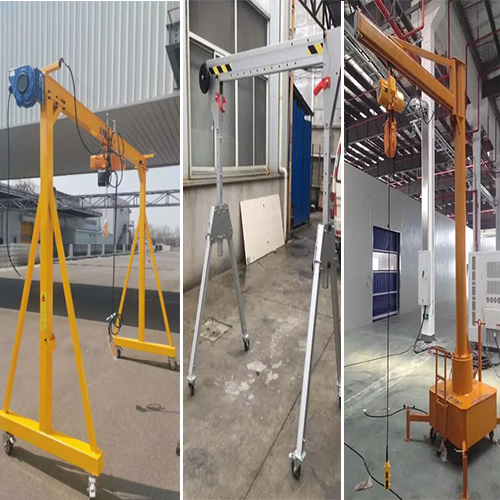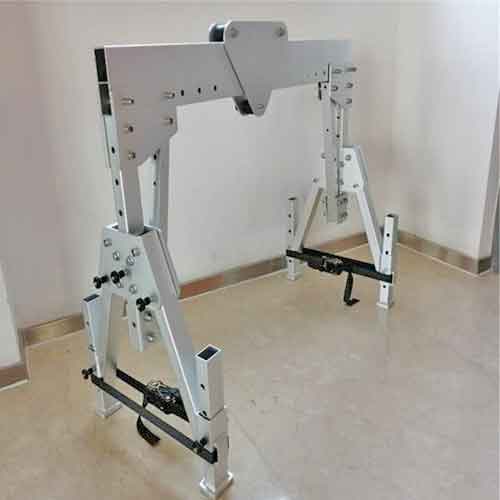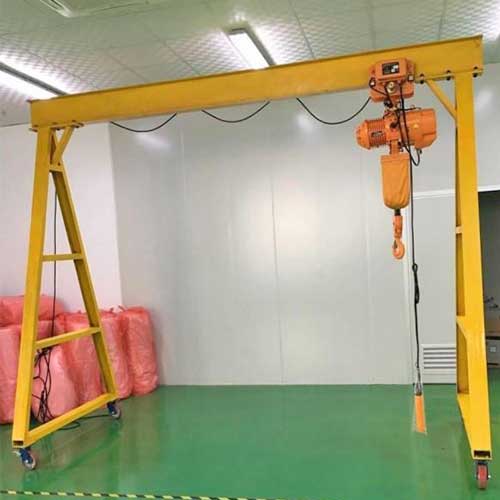Portable Cantilever Hoist & Portable jib crane hoist 0.5T, 1T, 2 T
Portable cantilever hoist for sale. Custom portable jib crane and hoists for sale, 500kg, 1000kg, 2000kg, light, economical & flexible portable jib hoist!
Category: Light Crane & Portable Crane
Your Trusted Portable Jib Cranes and Hoists Manufacturer & Supplier
Portable Cantilever Hoist & Portable jib crane hoist 0.5T, 1T, 2 T
Portable cantilever hoist for sale. Custom portable jib crane and hoists for sale, 500kg, 1000kg, 2000kg, light, economical & flexible portable jib hoist!
Unveiling the Power of Portable Cantilever Hoists
In the world of heavy lifting and maneuvering, precision, reliability, and efficiency reign supreme. That's where portable cantilever hoists or portable jib crane on wheels step in as the unsung heroes, offering a blend of convenience and strength that transform lifting operations across diverse industries.
But what exactly are portable cantilever hoists? These are versatile lifting devices designed with a cantilevered arm or beam extending horizontally from a supporting structure. This unique design allows for the seamless lifting and transportation of heavy loads with precision and ease. The hoist is equipped with a lifting mechanism, such as a chain hoist or electric winch, attached to the end of the cantilevered arm, enabling controlled and efficient lifting.
Picture a scenario where moving hefty objects within a confined workspace or across various sites becomes a daily challenge. Traditional fixed lifting systems might be limiting or impractical in such dynamic environments. This is where the portability of cantilever hoists shines through. They offer mobility and adaptability, addressing the need for a flexible lifting solution that can be moved to different locations as required.
The significance of these hoists lies not just in their ability to lift heavy loads, but in their versatility. They cater to the evolving demands of industries where the lifting and transporting of substantial materials or equipment are part and parcel of daily operations.
From workshops and warehouses to construction sites and manufacturing facilities, portable cantilever hoists play a pivotal role in streamlining lifting tasks, enhancing productivity, and ensuring the safety of operations.
Their functionality extends beyond merely lifting; they are precision tools that optimize workflow by providing a reliable means of handling heavy objects swiftly and securely.
Types of Portable Cantilever Hoists

Manual Cantilever Hoists
Manual cantilever hoists, the workhorses of lifting equipment, operate through the sheer force of human power. They are ingeniously designed to utilize hand-operated mechanisms, often employing chain hoists or ratchet levers, to lift and move heavy loads with precision and control. The user's physical effort engages the hoist's mechanism, allowing for the efficient elevation and positioning of materials.
Features and Benefits
The simplicity of manual cantilever hoists belies their remarkable capabilities. Their rugged construction ensures durability, while their straightforward operation makes them user-friendly and reliable. Moreover, their compact size and lightweight nature enhance their portability, allowing for easy transportation between workstations or job sites.
These hoists boast a range of benefits, including cost-effectiveness, minimal maintenance requirements, and suitability for smaller-scale lifting operations.
Typical Applications
From automotive repair shops to small-scale manufacturing units, manual cantilever hoists find their niche in diverse industries. They excel in scenarios where moderate lifting capacities are required, such as hoisting engines in garages or lifting materials in warehouses with limited space.

Electric Cantilever Hoists, click to check 2 ton portable cantilever hoist project
Electric cantilever hoists epitomize the amalgamation of technology and efficiency. They leverage electric motors to power their lifting mechanisms, offering enhanced precision and automation in lifting operations. These hoists come in various configurations, such as wire rope or chain-based systems, providing a tailored solution for different load capacities and applications.
Key Features and Advantages
The allure of electric cantilever hoists lies in their ability to handle heavier loads with ease. They boast impressive lifting capacities and can be operated remotely, reducing manual labor and enhancing safety. Variable speed control and smooth lifting capabilities make them ideal for delicate or complex lifting tasks.
Additionally, some models incorporate advanced safety features like overload protection and limit switches, ensuring secure and controlled lifting operations.
Applications in Various Industries
Electric cantilever hoists are the go-to choice in industries demanding heavy lifting, such as construction, manufacturing, and shipyards. Their ability to handle substantial loads while providing precise control makes them indispensable in scenarios requiring consistent and efficient lifting performance.

Cantilever Portable Jib Hoists:
Features:
- Compact Design: These hoists often have a compact and space-saving design, making them suitable for areas with limited space.
Manual or Electric Operation: Available in both manual and electric models, allowing users to choose based on their power source preference and lifting requirements. - 360-Degree Rotation: Many cantilever jib hoists offer full rotation, providing flexibility in positioning and lifting tasks within their radius.
- Sturdy Construction: Constructed with robust materials such as steel or aluminum to ensure durability and reliability during lifting operations.
Benefits:
- Versatility: Cantilever portable jib hoists offer versatility in lifting tasks, allowing for easy movement and precise positioning of loads within their range of motion.
- Space Efficiency: Their compact design enables installation in areas where traditional hoists might not fit, maximizing space utilization.
- Ease of Use: They are relatively easy to set up, operate, and maintain, making them ideal for various applications requiring quick and efficient lifting.

Articulating portable jib hoist
An articulating portable jib hoist, also known as a knuckle boom or knuckle jib hoist, is a specialized lifting device designed with multiple hinge points along its boom, allowing for enhanced maneuverability and flexibility in lifting operations. Unlike traditional jib hoists with fixed booms, articulating hoists offer increased articulation or bending capability.
Features:
- Multiple Hinge Points: Articulating jib hoists have multiple pivot points along their booms, enabling them to bend and articulate, similar to a human arm, offering greater flexibility and reach.
- Variable Reach and Positioning: The ability to articulate allows these hoists to reach around obstacles or into confined spaces that might be challenging for standard hoists with fixed booms.
- Enhanced Mobility: These hoists often come with swivel bases or mounts, allowing them to rotate horizontally, providing users with increased freedom in positioning the load.
- Variable Speed Control: Some models may offer variable speed control options, providing precise handling and control while lifting or positioning loads.
Benefits:
- Maneuverability: The articulating feature allows the hoist to navigate around obstacles or reach into areas that might be inaccessible to other types of hoists, increasing versatility.
- Precise Load Placement: The ability to articulate and reach with precision allows for accurate positioning of loads, reducing the need for manual adjustment or repositioning.
- Adaptability to Various Work Environments: Articulating jib hoists excel in environments where space is limited or where loads need to be maneuvered around obstacles, providing a solution for complex lifting scenarios.
Features and Benefits of Portable Cantilever Hoists
Robust Construction and Design
Portable cantilever hoists are engineered with durability at their core. Their robust construction, often made of high-quality steel or aluminum alloys, ensures resilience against heavy loads and rigorous usage. Precision engineering and adherence to stringent quality standards result in hoists capable of withstanding the demands of challenging lifting environments.
Portability and Mobility
The hallmark of these hoists lies in their mobility. Designed with the intent of being easily transportable, they often feature compact designs and integrated wheels or handles, facilitating effortless movement between workstations or job sites. This mobility empowers users with the flexibility to perform lifting tasks wherever needed, without being tethered to a fixed lifting system.
Versatility in Lifting Capacities
One of the standout attributes of portable cantilever hoists is their adaptability across a spectrum of lifting capacities. Whether handling lighter loads in smaller-scale operations or managing heavier materials in industrial settings, these hoists offer versatile solutions. They come in various load-bearing capacities, catering to the specific needs of different industries and applications.
Ease of Operation and Control
User-friendliness is a priority in the design of portable cantilever hoists. Equipped with intuitive controls and mechanisms, these hoists are designed to be easy to operate, ensuring swift and efficient lifting operations. Whether it's a manual hoist requiring straightforward hand-operated controls or an electric hoist offering remote operation, the emphasis on ease of control enhances user convenience and operational efficiency.
The ergonomic design of controls and handles minimizes operator fatigue, allowing for prolonged usage without compromising on precision or safety.
Industrial Applications of Portable Cantilever Hoists
Role in Enhancing Efficiency
Portable cantilever hoists stand as linchpins in revolutionizing industrial operations by significantly boosting efficiency. Their adaptability and mobility allow for streamlined workflows and optimized lifting processes.
In warehousing and logistics, these hoists facilitate the smooth movement of goods and materials, aiding in inventory management and expediting loading/unloading tasks. Their portability ensures swift repositioning to accommodate changing operational needs, minimizing downtime and maximizing productivity.
On construction sites, where the need for lifting heavy building materials is constant, these hoists provide a reliable means of transporting supplies to elevated locations. Their versatility in handling various loads enables seamless integration into construction workflows, reducing manual labor and accelerating project timelines.
In manufacturing facilities, portable cantilever hoists play a pivotal role in assembly lines, aiding in the manipulation of components and equipment. Their precision control allows for delicate positioning and accurate placement of machinery or parts, contributing to the overall efficiency of the production process.
Safety Considerations and Compliance
Safety remains paramount in industrial operations, and portable cantilever hoists are engineered with a focus on ensuring secure lifting practices. These hoists often incorporate safety features such as overload protection, emergency stop mechanisms, and limit switches to prevent accidents and protect both personnel and equipment.
Adherence to safety standards and compliance with regulations is a cornerstone of their design and usage. Regular maintenance, inspections, and operator training are essential components in ensuring the safe and effective operation of these hoists.
Employing these hoists in compliance with safety protocols not only mitigates risks but also enhances the overall efficiency of operations by minimizing downtime due to accidents or equipment failures.
Frequently Asked Questions about Portable Cantilever Hoists
What are the weight capacities of these hoists?
Portable cantilever hoists come in various weight capacities to suit different lifting requirements. Manual hoists may have lower capacities, typically ranging from a few hundred pounds to a couple of tons. Electric hoists, on the other hand, often offer higher weight capacities, ranging from one ton to several tons, depending on the model. It's crucial to check the manufacturer's specifications to ensure the hoist's capacity aligns with the intended lifting tasks.
How portable are these hoists, and what factors affect their mobility?
The portability of cantilever hoists is a defining feature. Most models are designed to be highly portable, featuring compact designs, integrated handles, and sometimes wheels for easy movement. Factors influencing their mobility include their size, weight, and the presence of specialized features like foldable arms or detachable components. Additionally, surface conditions and obstacles within the workspace can impact their ease of movement.
What maintenance is required for optimal performance?
Regular maintenance is crucial to ensure the optimal performance and longevity of portable cantilever hoists. This typically includes periodic inspections, lubrication of moving parts, checking for wear and tear, and verifying the functionality of safety features. Specific maintenance requirements may vary between manual and electric hoists, and it's advisable to follow the manufacturer's guidelines outlined in the user manual.
Are there specific safety guidelines for operation?
Absolutely. Safety is paramount when operating portable cantilever hoists. Users should undergo proper training on hoist operation and safety protocols. It's essential to follow all manufacturer-recommended guidelines for safe usage, including weight limits, proper attachment of loads, and regular equipment checks. Adhering to safety procedures, such as using appropriate personal protective equipment (PPE) and avoiding overloading, is critical to prevent accidents and ensure safe lifting operations.
How to choose the right hoist for a particular lifting task?
Choosing the right hoist depends on various factors, including the weight of the load, the frequency of use, the available space, and the specific requirements of the lifting task. Consider the weight capacity, lifting height, mobility features, and control mechanisms of the hoist. Understanding the load specifications and consulting with experts or manufacturers can aid in selecting the most suitable hoist for your needs.
Can these hoists be used in outdoor environments?
Portable cantilever hoists can be used in outdoor environments, but their performance might be affected by environmental conditions. Exposure to elements like rain, extreme temperatures, or corrosive substances may impact the hoist's durability and functionality. It's crucial to select hoists designed explicitly for outdoor use or take measures to protect them from adverse weather conditions to ensure longevity and safe operation.
What are the primary differences between various brands/models?
The differences between brands and models of portable cantilever hoists can encompass a range of aspects, including load capacity, construction materials, design features, safety mechanisms, and control options. Some models may offer additional safety features, such as overload protection or remote operation, while others might focus on compactness and ease of transportation. Variations in pricing, warranty, and customer support services also differentiate brands/models, allowing users to choose based on their specific requirements and preferences.
Main Projects
Related Products

Supplied three grab bucket crane kits to Indonesia, enhancing garbage handling efficiency with high load capacity and reliable performance.
Free consultation to Confirm Parameters & Specifications and Get
Latest Crane Price & Crane Rate.
- Types of overhead cranes : _______?
- Optional: Overhead travelling crane, goliath gantry crane,Slewing jib crane, Single girder or double girder crane,small portable crane or kbk crane, etc.
- Capacity of overhead crane: _______?
- Optional: 0.25ton, 0.5 ton, 1 ton, 2 ton, 3ton, 5 ton, 10 ton,15ton, 20ton, 25 ton, 30ton,35ton, up to 550ton, etc.
- Crane span & lifting height : _______?
- Crane travelling length : _____?
- Control of overhead crane:_______?
- Optional: pendant/ remote/cabin control
- Voltage supply of overhead crane:_____?
- Eg,: 380V50/60HZ,3Phase or others,etc.
- Application/usage of crane:_______?
- Eg,: Steel mill, ,injection mold, cement,stone, concrete,granite, general manufacturing, etc.
Just leave a message via the contact form and our hoist and crane engineer will contact you with in 24working hours.
Get In Touch
